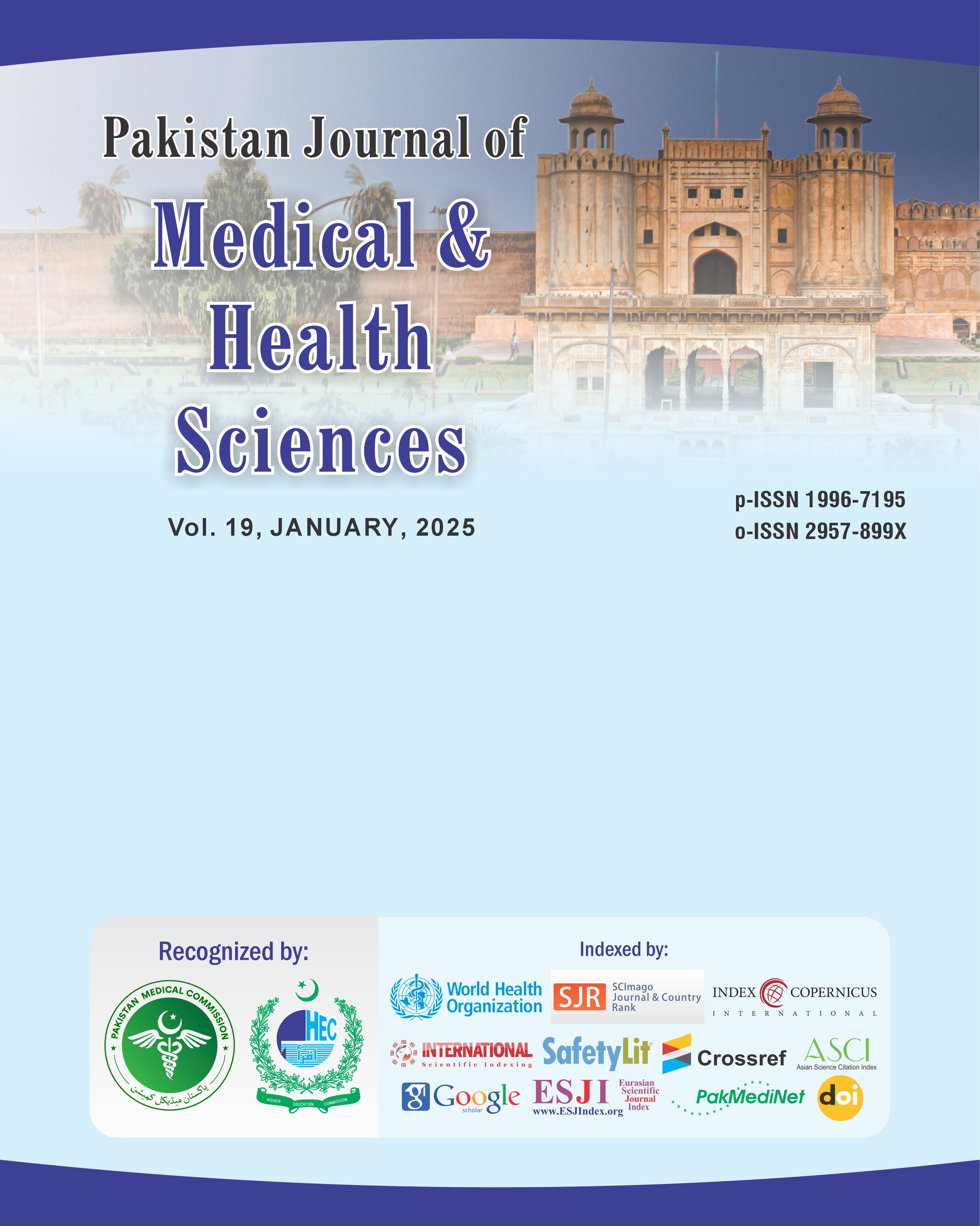Analysis the Role of Tumor-Infiltrating Lymphocytes as Prognostic Markers in Triple-Negative Breast Cancer - A Cross-Sectional Study
DOI:
https://doi.org/10.53350/pjmhs02025191.4Keywords:
Keywords: Breast Cancer, prognostic tool, Modulators. Tumor, Immune MicroenvironmentAbstract
Background: Triple negative breast cancer (TNBC) is an aggressive subtype that does not express hormone receptors or HER2, and therefore has few targeted treatment options. Tumor-infiltrating lymphocytes (TILs) have become established as promising prognostic markers of host immune response in TNBC.
Aim: To elucidate the immune landscape of TNBC to inform future immunotherapeutic strategies and maximize prognostic models in this challenging subtype of breast cancer.
Methodology: Using hematoxylin and eosin (H&E) staining, Formalin fixed paraffin embedded (FFPE) tissue slices from 79 patients with histologically confirmed triple negative breast cancer (TNBC) were retrospectively cross-sectionally analyzed. Tumor infiltrating lymphocytes (TILs) were evaluated in the stromal compartment in accordance with the International Immuno-Oncology Biomarker Working Group's standards. TILs were stratified as low (<10%), intermediate (10–49%), and high (≥50%). A total of clinical and pathological data (e.g. tumor size, nodal status, grade and survival) was collected and analyzed with SPSS. Chi square tests were used to examine associations between TIL levels and clinic pathological features and survival analyses were done by Kaplan–Meier and Cox regression methods.
Results: We found that 26.6% of TNBC patients had low TILs, 45.6% intermediate, and 27.8% had high TILs out of 79 TNBC patients. Small tumor size (p = 0.018), lower lymph node involvement (p = 0.027), and better tumor grade (p = 0.041) were significantly associated with high TIL levels. The results of Kaplan Meier analysis revealed higher DFS and OS in patients with high TIL (p=0.004 and p=0.011, respectively). High TILs were confirmed as independent predictors for favorable prognosis by multivariate Cox regression. Patients with low TILs were poor prognostic patients. These results suggest that TILs are a useful prognostic factor in TNBC.
Conclusion: Lymphocytes infiltrating into the tumor are higher in TNBC patients who have better survival outcomes. TIL assessment provides a useful, easily available prognostic tool for making clinical decisions
References
Johnson RH, Anders CK, Litton JK, et al. Breast cancer in adolescents and young adults. Pediatr Blood Cancer. 2018;65(12):e27397.
Tung N, Lin NU, Kidd J, et al. Frequency of germline mutations in 25 cancer susceptibility genes in a sequential series of patients with breast cancer. J Clin Oncol. 2016;34(13):1460–8.
Early Breast Cancer Trialists' Collaborative Group. Increasing the dose intensity of chemotherapy by more frequent administration or sequential scheduling: a patient-level meta-analysis of 37 298 women with early breast cancer in 26 randomised trials. Lancet. 2019;393(10179):1440–52.
Poorvu PD, Frazier AL, Feraco AM, et al. Cancer treatment-related infertility: a critical review of the evidence. JNCI Cancer Spectr. 2019;3(1):pkz008.
Menning S, de Ruiter MB, Kieffer JM, et al. Cognitive impairment in a subset of breast cancer patients after systemic therapy—results from a longitudinal study. J Pain Symptom Manage. 2016;52(4):560–9.e1.
Piccart M, van 't Veer LJ, Poncet C, et al. 70-gene signature as an aid for treatment decisions in early breast cancer: updated results of the phase 3 randomised MINDACT trial with an exploratory analysis by age. Lancet Oncol. 2021;22(4):476–88.
Sparano JA, Gray RJ, Makower DF, et al. Adjuvant chemotherapy guided by a 21-gene expression assay in breast cancer. N Engl J Med. 2018;379(2):111–21.
Champion VL, Wagner LI, Monahan PO, et al. Comparison of younger and older breast cancer survivors and age-matched controls on specific and overall quality of life domains. Cancer. 2014;120(15):2237–46.
Salgado R, Denkert C, Demaria S, et al. The evaluation of tumor-infiltrating lymphocytes (TILs) in breast cancer: recommendations by an International TILs Working Group 2014. Ann Oncol. 2015;26(2):259–71.
Adams S, Gray RJ, Demaria S, et al. Prognostic value of tumor-infiltrating lymphocytes in triple-negative breast cancers from two phase III randomized adjuvant breast cancer trials: ECOG 2197 and ECOG 1199. J Clin Oncol. 2014;32(27):2959–66.
Park JH, Jonas SF, Bataillon G, et al. Prognostic value of tumor-infiltrating lymphocytes in patients with early-stage triple-negative breast cancers (TNBC) who did not receive adjuvant chemotherapy. Ann Oncol. 2019;30(11):1941–9.
Loi S, Drubay D, Adams S, et al. Tumor-infiltrating lymphocytes and prognosis: a pooled individual patient analysis of early-stage triple-negative breast cancers. J Clin Oncol. 2019;37(7):559–69.
Dackus GM, Ter Hoeve ND, Opdam M, et al. Long-term prognosis of young breast cancer patients (≤40 years) who did not receive adjuvant systemic treatment: protocol for the PARADIGM initiative cohort study. BMJ Open. 2017;7(11):e017842.
Casparie M, Tiebosch AT, Burger G, et al. Pathology databanking and biobanking in The Netherlands, a central role for PALGA, the nationwide histopathology and cytopathology data network and archive. Cell Oncol. 2007;29(1):19–24.
Kos Z, Roblin E, Kim RS, et al. Pitfalls in assessing stromal tumor infiltrating lymphocytes (sTILs) in breast cancer. NPJ Breast Cancer. 2020;6(1):17.
Denkert C, Wienert S, Poterie A, et al. Standardized evaluation of tumor-infiltrating lymphocytes in breast cancer: results of the ring studies of the international immuno-oncology biomarker working group. Mod Pathol. 2016;29(10):1155–64.
Loi S, Michiels S, Salgado R, et al. Tumor infiltrating lymphocytes are prognostic in triple-negative breast cancer and predictive for trastuzumab benefit in early breast cancer: results from the FinHER trial. Ann Oncol. 2014;25(8):1544–50.
Loi S, Sirtaine N, Piette F, et al. Prognostic and predictive value of tumor-infiltrating lymphocytes in a phase III randomized adjuvant breast cancer trial in node-positive breast cancer comparing the addition of docetaxel to doxorubicin with doxorubicin-based chemotherapy: BIG 02-98. J Clin Oncol. 2013;31(7):860–7.
Leon-Ferre RA, Polley MY, Liu H, et al. Impact of histopathology, tumor-infiltrating lymphocytes, and adjuvant chemotherapy on prognosis of triple-negative breast cancer. Breast Cancer Res Treat. 2018;167(1):89–99.
Denkert C, von Minckwitz G, Brase JC, et al. Tumor-infiltrating lymphocytes and response to neoadjuvant chemotherapy with or without carboplatin in human epidermal growth factor receptor 2-positive and triple-negative primary breast cancers. J Clin Oncol. 2015;33(9):983–91.
Downloads
How to Cite
Issue
Section
License
Copyright (c) 2025 ARSLAN SHUJA, MUHAMMAD NASIR SHAHBAZ, MUZNA KASHIF, MAMOONA SHUJA, SALMAN TAHIR

This work is licensed under a Creative Commons Attribution 4.0 International License.


